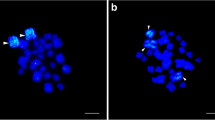Summary
-
1.
The heterochromosomes of crane-flies (Tipulidae) are sex chromosomes (XY in males), as could be demonstrated by the sex limited inheritance of Y-autosome translocations in Tipula oleracea, Pales crocata and P. ferruginea.
-
2.
Like the majority of tipulids the species more closely studied in the present contribution, P. ferruginea, possesses 3 pairs of large autosomes and small XY chromosomes, which are heteromorphic.
-
3.
The normal strain of P. ferruginea contains two types of size-different X-chromosomes, Xl and Xk, of a length ratio of 1∶1,4. They show normal mendelian inheritance and are viable in all combinations. X-chromosomes of different length have also been observed in Tipula paludosa and T. oleracea.
-
4.
Triploid larvae with normal spermatogenesis have been found in Tipula paludosa, Pales lunulicornis, and P. ferruginea. The triploid individuals of the two Pales species possess the sex-chromosome combination XXY.
-
5.
In P. ferruginea a strain with supernumerary sex chromosomes has been found. In crosses of XYY males of this strain with normal XX females, besides XX females, XY and XYY males, also XXY males occur which are fertile. Their occurrence proves the existence of an epistatic male determining factor (or factors) in the Y. Presence or absence of Y thus is responsible for sex realisation.
Similar content being viewed by others
Literatur
Bauer, H.: Die Chromosomen von Tipula paludosa Meig. in Eibildung und Spermatogenese. Z. Zellforsoh. 14, 138–193 (1931).
—, R. Dietz u. C. Röbbelen: Die Spermatocytenteilungen der Tipuliden. III. Mitt.: Das Bewegungsverhalten der Chromosomen in Translokationsheterozygoten von Tipula oleracea. Chromosoma (Berl.) 12, 116–189 (1961).
Bayreuther, K.: Die Oogenese der Tipuliden. Chromosoma (Berl.) 7, 508–557 (1956).
Beermann, W.: Geschlechtsbestimmung und Evolution der genetischen Y-Chromosomen bei Chironomus. Biol. Zbl. 74, 525–544 (1955).
Bridges, C. B.: Non-disjunction as proof of the chromosome theory of heredity. Genetics 1, 1–52 (1916).
—: The origin of variations in sexual and sex limited characters. Amer. Naturalist 56, 51–63 (1922).
Clayton, F. E., and C. L. Ward: Chromosomal studies of several species of Drosophilidae. Univ. Texas Publ. 5422, 98–105 (1954).
—, and M. Wasserman: Chromosomal studies of several species of Drosophila. Univ. Texas Publ. 5721, 125–131 (1957).
Dobzhansky, T.: The Y-chromosomes of Drosophila pseudoobscura. Genetics 20, 366–376 (1935).
—: Further data on the variation of the Y-chromosome in Drosophila pseudoobscura. Genetics 22, 340–346 (1937).
Gripenberg, U.: Size variation and orientation of the human Y-chromosome. Chromosoma (Berl.) 15, 618–629 (1964).
Hartmann, M.: Die Sexualität, 2. Aufl. Stuttgart: Gustav Fischer 1956.
Heitz, E.: Die somatische Heteropyknose bei Drosophila melanogaster und ihre genetische Bedeutung (Cytologische Untersuchungen an Dipteren. III.) Z. Zellforsch. 20, 237–287 (1933).
Henderson, S. A., and T. Parsons: The chromosomes of eleven species of tipulid. Caryologia (Firenze) 16, 337–346 (1963).
John, B.: XY segregation in the crane fly Tipula maxima (Diptera, Tipulidae). Heredity 11, 209–215 (1957).
Keuneke, W.: Über die Spermatogenese einiger Dipteren. Z. Zellenlehre 1, 357–412 (1924).
Lyon, M. F.: Sex chromatin and gene action in the mammalian X-chromosome. Amer. J. hum. Genet. 14, 135–148 (1962).
Makino, S., M. S. Sasaki, K. Yamada, and T. Kajii: A long Y chromosome in man. Chromosoma (Berl.) 14, 154–161 (1963).
—, K. Yamada, and G. Kohno: A long Y chromosome in male twin-brothers and their father. Proc. Jap. Academy 39, 770–773 (1963).
Metz, C. W.: Chromosome studies on the Diptera. IV. Incomplete synapsis of chromosomes in Dasyllis grossa Fabr. Biol. Bull. 43, 253–266 (1922).
Ohno, S., and C. Weiler: Sex chromosome behavior pattern in germ and somatic cells of Mesocricetus auratus. Chromosoma (Berl.) 12, 362–373 (1961).
Russell, L. B.: Genetics of mammalian sex chromosomes. Mouse studies throw light on the functions and on the occasionally aberrant behavior of sex chromosomes. Science 133, 1795–1803 (1961).
Ullerich, F.-H.: Geschlechtschromosomen und Geschlechtsbestimmung bei einigen Calliphorinen (Calliphoridae, Diptera). Chromosoma (Berl.) 14, 45–110 (1963).
Ward, C. L.: Karyotype variation in Drosophila. Univ. Texas Publ. 4720, 70–77 (1947).
White, M. J. D.: Animal cytology and evolution, 2nd ed. Cambridge: Cambridge Press 1954.
Wolf, B. E.: Die Chromosomen in de Spermatogenese einiger Nematoceren. Chromosoma (Berl.) 2, 192–246 (1941).
Author information
Authors and Affiliations
Rights and permissions
About this article
Cite this article
Ullerich, F.H., Bauer, H. & Dietz, R. Geschlechtsbestimmung bei tipuliden. Chromosoma 15, 591–605 (1964). https://doi.org/10.1007/BF00319993
Received:
Issue Date:
DOI: https://doi.org/10.1007/BF00319993




